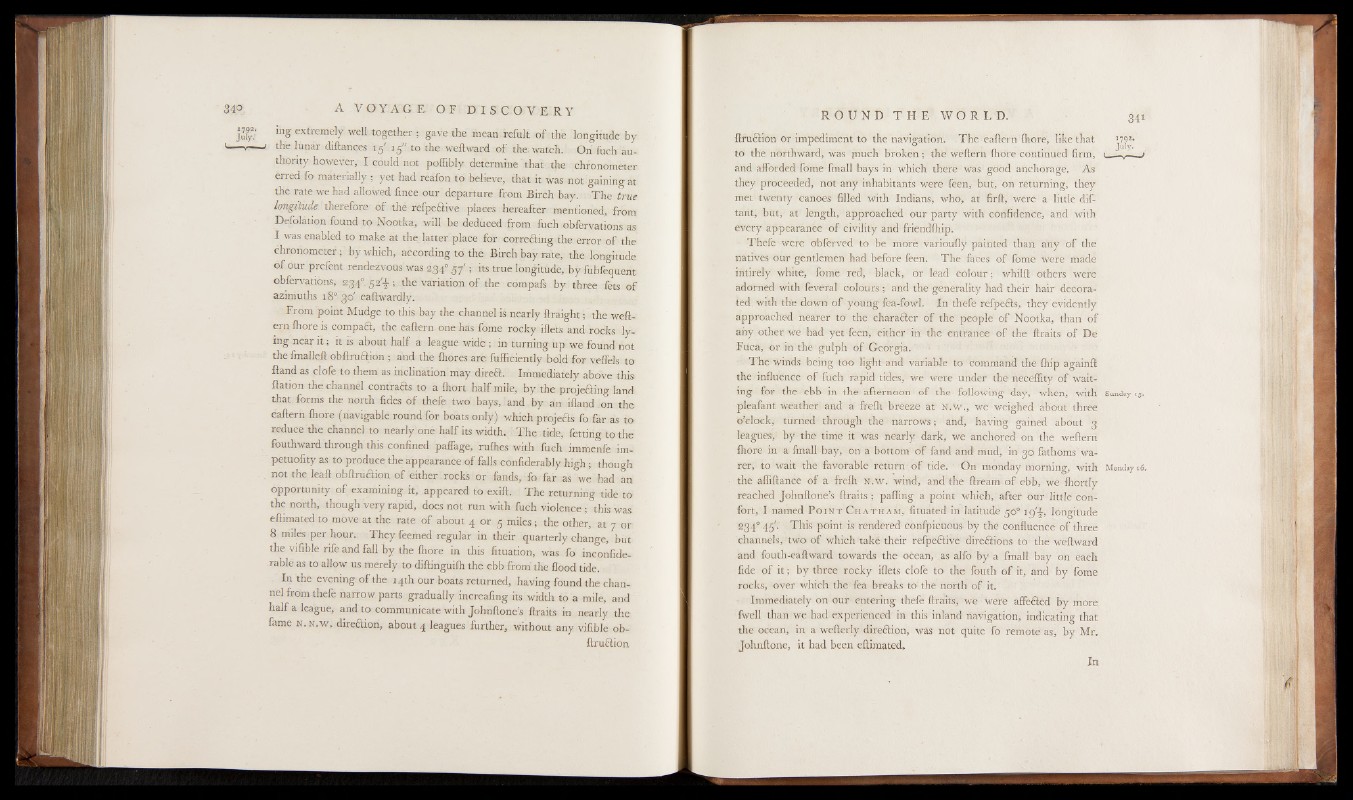
ing extremely well together ; gave the mean refult of the longitude by
the lunar diftances 15' 15" to the weftward of the. watch. On fuch authority
however, I could not poffibly determine that the chronometer
erred fo materially ; yet had reafon to believe, that it was not gaining at
the rate we had allowed fince our departure from Birch bay. . The true
longitude therefore of the refpeftive places hereafter mentioned, from
Defolation found to Nootka, will be deduced from fuch obfervations as
I was enabled to make at the latter place for correffing the error o f the
chronometer; by which, according to the Birch bay rate, the longitude
of our prefent rendezvous was 234° 5 7'; its true longitude, by fubfequent
obfervations, 234°. 5 2 'f ; the variation of the compafs by three fits of
azimuths 18° 30' eaftwardly.
From point Mudge to this bay the channel is nearly flraight; the weft-
ern fhore is compafl, the eaftern one has fome rocky iflets and rocks lying
near i t ; it is about half a league wide ; in turning up we found not
the fmalleft obftruction ; and the Chores are fufficiently bold for yeffels to
Hand as clofe to them as inclination may direft. Immediately above this
ftation the channel contrafts to a ffiort half mile, by the proje&ng land
that forms the north fides of thefe two bays, and by an ifland on the
eaftern ffiore (navigable round for boats only) which projects fo far as to
reduce the channel to nearly one half its width. The tide, fetting to the
fouthward through this confined paflage, ruffies with fuch immenfe im-
petuofity as to produce the appearance of falls confiderably high ; though
not the leaf! obftruftion of either rocks or bands, fo far as we had an
opportunity of examining it, appeared to exift. The returning tide to
the north, though very rapid, does not run with fuch violence ; this was
eftimated to move at the rate of about 4 or 5 miles; the other, at 7 or
8 miles per hour. They feemed regular in their quarterly change, but
the vifible rife and fall b y the ffiore in this fituation, was fo inconfide-
rablé as to allow us merely to diftinguiffi the ebb from the flood tide.
In the evening of the 14th our boats returned, having found the channel
from thefe narrow parts gradually increafing its width to a mile, and
half a league, and to communicate with Johnftone’s ftraits in nearly the
fame n.n.w . direótion, about 4 leagues further, without any vifible obftruólion
R O U N D T H E W O R L D . 341
ftruHion or impediment to the navigation. The eaftern ffiore, like that
to the northward, was much broken; the Weftern ffiore continued firm,
and afforded fome fmall bays in which there was- good anchorage. As
they proceeded, not any inhabitants were feen, but, on returning, they
met twenty canoes filled with Indians, who, at firft, were a little dif-
tant, but, at length, approached our party with confidence, and with
every appearance o f civility and friendffiip.
Thefe were obferved to be moré varioufly painted than any o f the
natives our gentlemen had before feen. The faces of fome were made
intirely white, fome red, black, or lead colour; whilft others were
adorned with feveral colours ; and the generality had their hair decorated,
with the down of young fea-fowl. In thefe refpefts, they evidently
approached nearer to the character o f the people of Nootka, than of
any other we had yet feen, either in the entrance of the ftraits of De
Fuca, or in the gulph of Georgia. ‘
The winds being too light and variable to command the (hip againft
the influence o f fuch rapid tides, we were under the necéffity o f waiting
for the ebb in the afternoon of the following day, when, with
pleafant weather and a freffi breeze at N.w., we weighed about three
o’clock, turned through the narrows; and, having gained about 3
leagues-, by the time it was nearly dark, we anchored on the weftern
ffiore in a fmall bay, on a bottom o f fand and mud, in 30 fathoms wa-
1792.
July.
Sunday 15.
rer, to wait the favorable return of tide. On mondây morning, with Monday 16.
the affiftance of a freffi N.w. wind, and the ftream of ebb,, we ffiortly
reached Johnftone’s ftraits; paffing a point which, after our little con-
fort, I named P o in t C h a t h am , fituated in latitude 50” ig '| y longitude
2340 45'. This point is rendered confpicuous by the confluence of three
channels, two of which takë their refpeftivé direélions to the weftward
and fouth-eaftward towards the ocean, as alfo by a fmall bay on each
fide of i t ; by three rocky iflets clofe to the fouth o f it, and by fome
rocks, over which the fea breaks to the north of it.
Immediately on our entering thefe ftraits, we were affefled by more
fwell than we had experienced in this inland navigation, indicating that
the ocean, in a wefterly dire&ion, was not quite fo remote as, by Mr.
Johnftone, it had been eftimated.
In